Topics
Category
Era
I-35W Bridge Collapse
The I-35W (Interstate 35 West) bridge over the Mississippi River in Minneapolis opened to traffic in 1967. Thousands of vehicles drove across it every day, but no one imagined that a mistake in the bridge’s design, made over forty years prior, would have such disastrous consequences on one summer evening in August of 2007.
The I-35W bridge, given the designation “Bridge 9340,” was designed by a civil engineering company called Sverdrup & Parcel in the early 1960s. Construction on the bridge began in 1964, towards the end of the national highway construction boom that aimed to dramatically develop the roadway infrastructure of the United States. The bridge opened to traffic in late 1967.
Bridge 9340 consisted of fourteen spans: nine spans were of steel multi-girder construction, two were of concrete slab construction, and the main three were of deck truss construction. The Minnesota Department of Transportation, also known as MnDOT, was tasked with taking over annual bridge inspection beginning in 1993. Prior to this, it was federally inspected every other year.
Inspection reports by MnDOT often indicated significant corrosion, rusting, warped plates, and other structural issues with the bridge. It was noted that the lack of redundancy in the main truss design meant that the bridge was vulnerable to a collapse if a single critical piece in the truss were to fail. Subsequent inspection reports expressed concern about the bridge’s structural integrity, labelling it a “fracture critical bridge,” but no motion to close or drastically reinforce it was ever made.
On the evening of August 1, 2007, slow-moving traffic descended on the I-35W bridge during peak rush hour as it had done countless times before; however, at precisely 6:05 pm CDT, the unthinkable happened. Drivers on the bridge recalled hearing a beam snap, followed by a loud clank! Then, they felt the bridge begin to tremble. Within seconds, 1,000 feet of the bridge collapsed, and about 456 feet of the main span fell 108 feet down into the Mississippi River and its banks. Thirteen people were killed and 145 were injured as a result.
Emergency responders arrived on the scene within six minutes of the collapse. Only a handful of vehicles fell into the water, while many were trapped atop pieces of the broken bridge. A school bus with fifty-two children and nine adults was among the vehicles stranded on the wreckage. Twenty-year-old Jeremy Hernandez, a staff member onboard the bus, was critical to getting the children to safety.
Panic and fear spread across the country as the news broke out, and observers wondered how this could have happened. Within twenty-four hours of the bridge collapse, investigators from the National Transportation Safety Board (NTSB) arrived on the scene to figure out the root cause of the tragedy. Investigators looked at the weather, traffic patterns, and even the type of solvent used to melt ice that built up in wintertime. Ultimately, they determined that a deciding factor in the collapse had to do with nearly 300 tons of construction equipment placed right over a critical flaw in the bridge’s design—gusset plate U10. The bridge’s deck truss design included fourteen gusset plates, large steel sheets meant to connect girders to the truss structure. Plate U10, which was half an inch thick when it should have been one inch thick, was calculated as being the weakest of the fourteen.
This determination by the NTSB meant that a mistake made over forty years before the collapse led to the bridge’s ultimate failure in 2007. The critical design flaw was missed by over forty years of inspections, both state and federal, because checking for such design flaws after the fact was not standard practice.
The tragedy that unfolded in Minneapolis on that summer day in 2007 caused a rift that reached every corner of the nation. Government officials everywhere felt urged to ramp up inspections and funnel money towards renovating and maintaining their traffic infrastructure; but, as was proved by the Minneapolis bridge collapse, local government often lacks the funds to deal properly with crumbling infrastructure. It has been estimated that over a trillion dollars are needed to make repairs. This money has been difficult to attain, and local governments across the country continue to struggle to keep up with the cost of maintenance and safety.
Bibliography
Cavanaugh, Patricia. “Politics and Freeways: Building the Twin Cities Interstate System.” Report prepared for the Minneapolis Center for Urban and Regional Affairs (CURA) and the Center for Transportation Studies (CTS), University of Minnesota.
https://conservancy.umn.edu/bitstream/handle/11299/2082/Freeways.pdf
“Crumbling Bridges: US Infrastructure 10 Years After Minneapolis.” Retro Report, March 23, 2018. https://www.retroreport.org/video/mini-doc/crumbling-bridges-us-infrastructure-10-years-after-minneapolis
Davey, Monica, and Matthew L. Wald. “Steel Plates May Be Design Flaw in Minn. Bridge Collapse.” New York Times, August 9, 2007.
Holt, Reggie, and Joseph Hartmannn. “Adequacy of the U10 & L11 Gusset Plate Designs for the Minnesota Bridge No. 9340 (I-35W over the Mississippi River), Interim Report.” Federal Highway Administration, January 11, 2008.
https://web.archive.org/web/20101222190748/http://ntsb.gov/Recs/letters/2008/H08_1_Design_Adequacy_Report.pdf
Kennedy, Tony, and Paul McEnroe. “I-35W Bridge Collapse: Hard-to-see Spots Had Most Risks.” Minneapolis Star-Tribune, August 7, 2007.
“The Minneapolis Bridge Collapse that Sounded the Alarm on US Infrastructure.” Retro Report, March 4, 2014.
https://www.retroreport.org/video/when-a-bridge-falls
Minnesota Department of Transportation. “Office of Investment Management; Research Services Section Report, 2001–2006.” October 2006.
https://mdl.mndot.gov/items/m16026
National Transportation Safety Board. “Collapse of I-35W Highway Bridge, Minneapolis, Minnesota, August 1, 2007.” Highway Accident Report NTSB/HAR-08/03. Washington, DC, 2008. https://www.ntsb.gov/investigations/AccidentReports/Reports/HAR0803.pdf
Stawicki, Elizabeth. “Why Did the Bridge Collapse?” MPR News, August 2, 2007. https://www.mprnews.org/story/2007/08/02/inspection
Wiggins, Leslie. “Kids On School Bus Survive Mississippi River Bridge Collapse.” CNN News, August 2, 2007.
http://www.cnn.com/2007/US/08/02/bridge.collapse.schoolbus/#cnnSTCText
Related Resources
Primary
Interstate 35-W Bridge collapse photograph collection
Sound and Visual Collection, Minnesota Historical Society, St. Paul
Description: PS1 Kevin Rofidal, member of the U.S. Coast Guard, took these images while assisting in response and recovery efforts after the Interstate 35W bridge collapsed in Minneapolis. Images were taken August 1–4 and depict scenes of wreckage, abandoned vehicles, bridge sections, recovery work, the Coast Guard, and other workers assisting in recovery efforts.
Holding Location: Minnesota Historical Society
http://www2.mnhs.org/library/findaids/sv000045.xml#a9
Web
“File: I-35W Bridge Collapse.” YouTube video, 0:46. “Pioneer Press,” March 7, 2013. https://www.youtube.com/watch?v=VwrPF7ccfEg
“I-35W Bridge Collapse Structure and Components and Initial Failure.” YouTube video, 4:35. “NTSBgov,” November 27, 2013.
https://www.youtube.com/watch?v=5L6fsel9hwg
Related Images
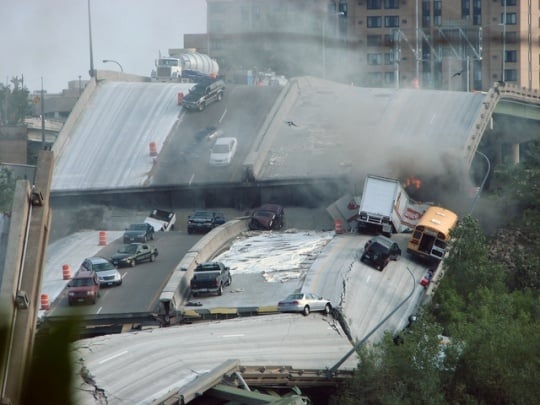
I-35W bridge after collapse
Holding Location
Articles
More Information
_(1010627439).jpg)
Minneapolis I-35W bridge collapse (smoke)
Holding Location
Articles
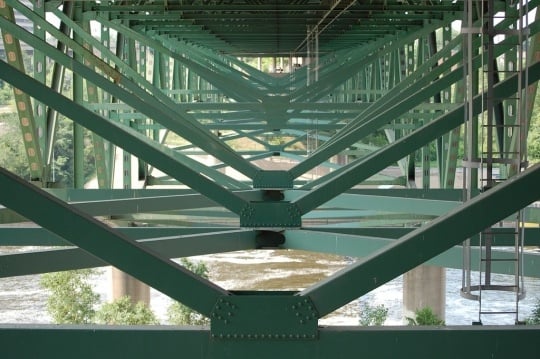
I-35W bridge structure
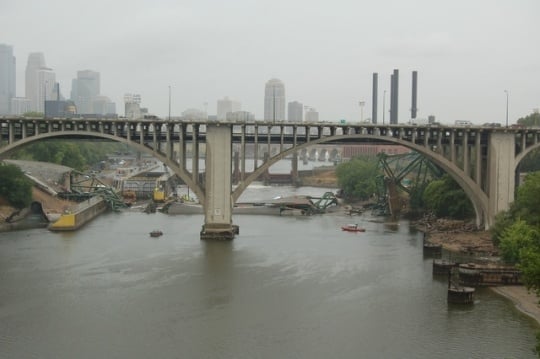
I-35W wreckage
Holding Location
Articles
More Information
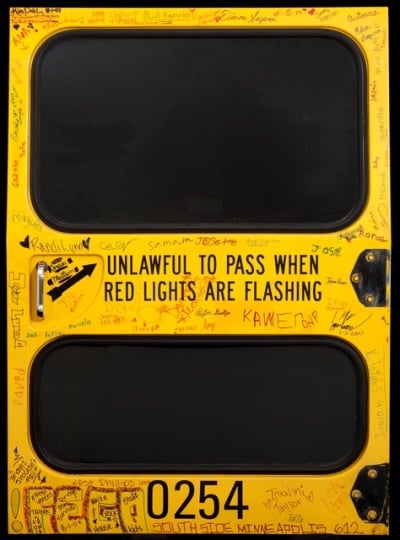
Emergency exit door from school bus involved in I-35W bridge collapse
All rights reserved
Holding Location
Articles
More Information
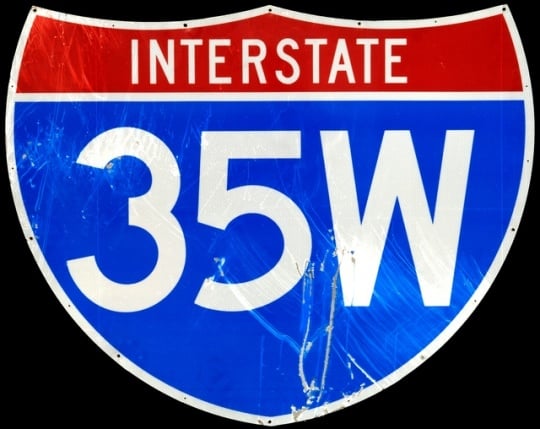
I-35W shield sign from bridge 9340
All rights reserved
Articles
More Information
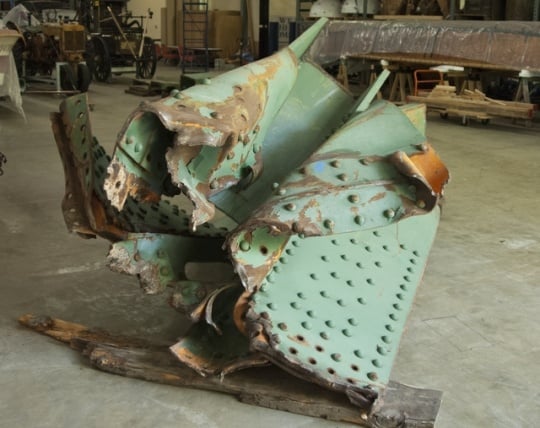
I-35W bridge (Bridge 9340) component
All rights reserved
Articles
More Information
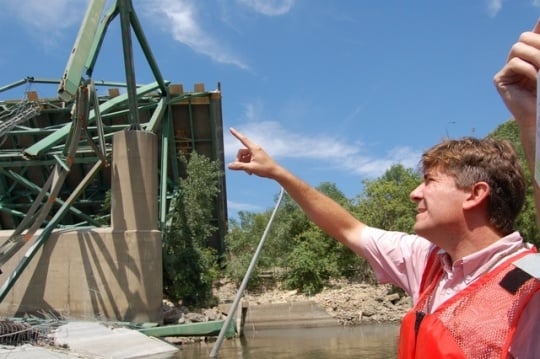
Worker pointing to collapsed Interstate 35W bridge
Articles
More Information
Turning Point
During peak rush hour at 6:05 pm CDT on Wednesday, August 1, 2007, the gusset plates holding the I-35W highway bridge over the Mississippi River experience a catastrophic failure. As a result, the main span of the bridge’s deck truss collapses, falling 108 feet (about ten stories) down into the river.
Chronology
1964
1967
1990
2006
2007
2008
Bibliography
Cavanaugh, Patricia. “Politics and Freeways: Building the Twin Cities Interstate System.” Report prepared for the Minneapolis Center for Urban and Regional Affairs (CURA) and the Center for Transportation Studies (CTS), University of Minnesota.
https://conservancy.umn.edu/bitstream/handle/11299/2082/Freeways.pdf
“Crumbling Bridges: US Infrastructure 10 Years After Minneapolis.” Retro Report, March 23, 2018. https://www.retroreport.org/video/mini-doc/crumbling-bridges-us-infrastructure-10-years-after-minneapolis
Davey, Monica, and Matthew L. Wald. “Steel Plates May Be Design Flaw in Minn. Bridge Collapse.” New York Times, August 9, 2007.
Holt, Reggie, and Joseph Hartmannn. “Adequacy of the U10 & L11 Gusset Plate Designs for the Minnesota Bridge No. 9340 (I-35W over the Mississippi River), Interim Report.” Federal Highway Administration, January 11, 2008.
https://web.archive.org/web/20101222190748/http://ntsb.gov/Recs/letters/2008/H08_1_Design_Adequacy_Report.pdf
Kennedy, Tony, and Paul McEnroe. “I-35W Bridge Collapse: Hard-to-see Spots Had Most Risks.” Minneapolis Star-Tribune, August 7, 2007.
“The Minneapolis Bridge Collapse that Sounded the Alarm on US Infrastructure.” Retro Report, March 4, 2014.
https://www.retroreport.org/video/when-a-bridge-falls
Minnesota Department of Transportation. “Office of Investment Management; Research Services Section Report, 2001–2006.” October 2006.
https://mdl.mndot.gov/items/m16026
National Transportation Safety Board. “Collapse of I-35W Highway Bridge, Minneapolis, Minnesota, August 1, 2007.” Highway Accident Report NTSB/HAR-08/03. Washington, DC, 2008. https://www.ntsb.gov/investigations/AccidentReports/Reports/HAR0803.pdf
Stawicki, Elizabeth. “Why Did the Bridge Collapse?” MPR News, August 2, 2007. https://www.mprnews.org/story/2007/08/02/inspection
Wiggins, Leslie. “Kids On School Bus Survive Mississippi River Bridge Collapse.” CNN News, August 2, 2007.
http://www.cnn.com/2007/US/08/02/bridge.collapse.schoolbus/#cnnSTCText
Related Resources
Primary
Interstate 35-W Bridge collapse photograph collection
Sound and Visual Collection, Minnesota Historical Society, St. Paul
Description: PS1 Kevin Rofidal, member of the U.S. Coast Guard, took these images while assisting in response and recovery efforts after the Interstate 35W bridge collapsed in Minneapolis. Images were taken August 1–4 and depict scenes of wreckage, abandoned vehicles, bridge sections, recovery work, the Coast Guard, and other workers assisting in recovery efforts.
Holding Location: Minnesota Historical Society
http://www2.mnhs.org/library/findaids/sv000045.xml#a9
Web
“File: I-35W Bridge Collapse.” YouTube video, 0:46. “Pioneer Press,” March 7, 2013. https://www.youtube.com/watch?v=VwrPF7ccfEg
“I-35W Bridge Collapse Structure and Components and Initial Failure.” YouTube video, 4:35. “NTSBgov,” November 27, 2013.
https://www.youtube.com/watch?v=5L6fsel9hwg



_(1010627439).jpg?width=200&height=200&name=Minneapolis_I-35W_Bridge_Collapse_(smoke)_(1010627439).jpg)





